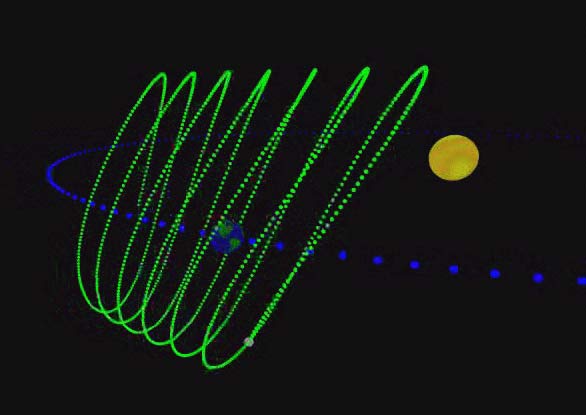Corkscrewing Asteroid Departs Earth's Vicinity

An asteroid that has been corkscrewing around Earth in recent years is heading for deep space today, according to NASA.
The object, named 2003 YN107, was discovered in 2003. It arrived in Earth's vicinity 1999, scientists have calculated.
"It's been corkscrewing around Earth ever since." said Paul Chodas of NASA's Near Earth Object Program at JPL.
The rock is relatively small and is not a threat to hit the planet.
Captured
Most space rocks that approach Earth fly on by.
"We believe 2003 YN107 is one of a whole population of near-Earth asteroids that don't just fly by Earth," Chodas said. "They pause and corkscrew in our vicinity for years before moving along."
Get the Space.com Newsletter
Breaking space news, the latest updates on rocket launches, skywatching events and more!
These asteroids are called Earth co-orbital asteroids or "co-orbitals." They share Earth's orbit, circling the Sun in almost exactly a year. They can catch up to Earth from behind or Earth can catch them.
"These asteroids are not truly captured by Earth's gravity," Chodas said in a NASA statement issued this week. "But from our point of view, it looks like we have a new moon."
Similar objects
At least four small asteroids behave similarly: and 2001 GO2, 2002 AA29, 2004 GU9 and 2003 YN107. More likely exist but await discovery by improved search technology.
And an object known as Cruithne is trapped in a suspended state around Earth for at least 5,000 years.
The corkscrew path of 2003 YN107 is lopsided and today it will dip within 2.1 million miles (3.4 million kilometers) of Earth, slightly closer than usual, according to NASA. Earth's real Moon is 238,900 miles miles away.
Earth's gravity will then give the asteroid a nudge and send it on its way.
In about 60 years 2003 YN107 will lap Earth again, resuming its role as a temporary, corkscrewing moonlet.
- Image Gallery: The Moon
- More Moons Around Earth? Its Not So Loony
- Earths New Travelling Companion: Quasi-Satellite Discovered
- Closest Flyby of Large Asteroid to be Naked-Eye Visible
- The Disappearing Moon: Why and Where it Hides
Join our Space Forums to keep talking space on the latest missions, night sky and more! And if you have a news tip, correction or comment, let us know at: community@space.com.

Space.com is the premier source of space exploration, innovation and astronomy news, chronicling (and celebrating) humanity's ongoing expansion across the final frontier. Originally founded in 1999, Space.com is, and always has been, the passion of writers and editors who are space fans and also trained journalists. Our current news team consists of Editor-in-Chief Tariq Malik; Editor Hanneke Weitering, Senior Space Writer Mike Wall; Senior Writer Meghan Bartels; Senior Writer Chelsea Gohd, Senior Writer Tereza Pultarova and Staff Writer Alexander Cox, focusing on e-commerce. Senior Producer Steve Spaleta oversees our space videos, with Diana Whitcroft as our Social Media Editor.









